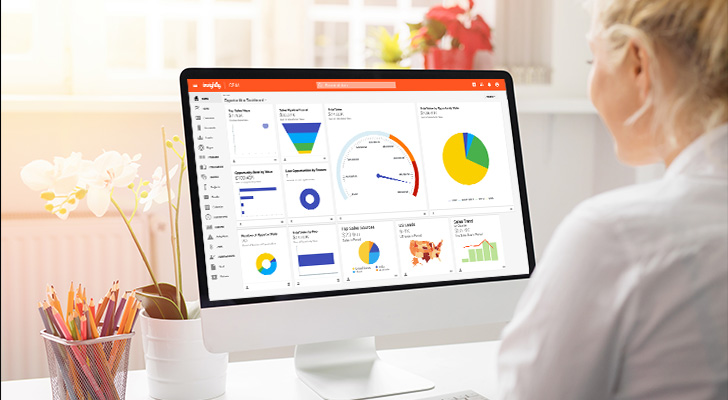As much as every business leader wishes there were more hours in the workday, time is one thing that’s beyond even the best manager’s remit. Thankfully, you can use CRM automation to automate workflows and give your team more time to do high-value functions instead of menial tasks.
What is CRM automation?
CRM automation eliminates manual tasks by using software to handle repetitive sales and customer service activities.
Instead of your team typing contact details, sending follow-up emails, or updating deal stages by hand, the system does it automatically. Set up the rules once. Watch it work forever.
Picture this:
A prospect downloads your pricing guide at 11 p.m. on a Friday. Your CRM automation system instantly adds them to a nurture sequence, assigns a follow-up task to the right sales rep, and scores them based on their activity. No weekend work required.
How CRM automation actually works
The magic primarily happens through if/then logic.
A robust CRM platform watches for specific triggers like form submissions, email opens, or deal value changes. When those conditions are met, it fires off predetermined actions.
Here’s what that could look like in simple terms:
- When a deal reaches $10,000 → alert the sales manager
- When a customer hasn’t been contacted in 30 days → create a follow-up task
- When someone abandons their cart → send a recovery email sequence
- When a lead visits your pricing page three times → bump their lead score
You configure the rules once. The software handles the rest — 24/7, without breaks, without forgetting.
CRM automation vs marketing automation
Marketing automation handles your top-of-funnel tasks. CRM automation manages your sales process and customer relationships.
Both tools do the same basic thing — remove manual work from your team’s day. No more typing contact details by hand. No more forgetting to send follow-up emails. No more losing track of where each lead stands in your pipeline.
Here’s where they focus differently:
Marketing automation handles repetitive marketing tasks. It sends email campaigns automatically, tracks visitor behavior on your website, scores leads based on their activity, and manages campaign performance. Your marketing team sets up the workflows once, then the system handles the busy work.
CRM automation takes care of sales and service workflows. It assigns leads to the right reps, creates follow-up tasks, moves deals through pipeline stages automatically, and tracks customer interactions. Your sales team focuses on building relationships instead of managing data.
Most growing businesses need both working together. When marketing automation identifies a hot lead, your CRM platform should immediately know their complete history. What emails they opened. Which pages they visited. How they scored across different campaigns.
Without that connection, leads fall through the cracks. Your sales rep calls someone cold who’s actually been engaging with your content for weeks.
The smart move? Find a solution that combines both systems with a shared database. Your teams stay aligned, handoffs happen automatically, and you avoid paying for multiple subscriptions that don’t talk to each other.
What are the core benefits of CRM automation software?
CRM automation helps you streamline your entire operation by reducing manual input and low-level tasks. However, its advantages aren’t limited to processes and procedures. It also improves customer service by providing agents with instant access to customer data and speeding up response times.
Your sales reps can use sales automation in CRM to offer seamless, customized service, using high-level data about each customer. Likewise, customer support teams can use it to identify and resolve queries and complaints more efficiently and effectively.
Faster customer service response times
Automation tools allow customer service reps to instantly access customer data, so they can respond to service issues in a confident and knowledgeable manner. What’s more, these tools allow your company to provide 24/7 access to support without the need to have people working around the clock.
For many customers, not having a way to contact your business on their own terms leads to frustration and has a drastic impact on customer experience. If they have an easy way to leave details of their issue and request a response within a reasonable timeframe, it leaves them with a significantly better impression of your company.
A major bonus for your company is the practically unlimited amount of data a CRM with automation can capture. You can measure and assess this data to learn in-depth insights about your target market to refine and personalize your sales processes, forecasting capabilities and marketing campaigns for the future.
Examples of how CRM automation can speed up customer service include:
- Chatbots that offer instant answers to frequently asked questions, record customer details, escalate requests to a relevant team player, and allow chatters to open up support tickets from within a chat
- Automated management of requests for product guides, online resources, whitepapers, e-books and other content
- Sending welcome, thank you and follow-up emails to contacts
- Combining data across a range of channels, such as social media, calls, chatbot and email, to give agents a bird’s-eye view of each lead
Increased sales team productivity
The enriched data afforded by a robust CRM automation system and strategy has a positive impact on sales productivity. CRM software uses automation to comb through, filter, structure and input data in a fraction of the time it would take a person. Making predictions and forecasts, transcribing conversations, qualifying leads and moving them through the sales pipeline are complex, time-consuming tasks that a CRM can automate.
Not only does this save sales reps time and increase the accuracy and specificity of the data gathered, it also means reps can offer a truly personalized service. The information they glean from the CRM gives them an unparalleled understanding of buyer intent, allowing them to consistently develop a rapport and establish trust with each lead. This allows reps to focus on prospects who are most likely to buy and increase conversion rates across all channels.
Plus, it’s easy for people to forget small but important bits of information, but a CRM never forgets. Does your lead’s daughter play soccer? What’s his Starbucks order? Does she root for the Vikings? Recording these notes in the CRM means that you can offer a personal touch on the next contact. And the one after that. As such, fewer deals slip through the net as a result of human forgetfulness. Also, should a rep leave your organization, that knowledge doesn’t leave with him or her.
Improved task tracking and management
Sales reps often end up with enormous to-do lists, and reducing the number of menial tasks frees them up to build relationships and sell. Task tracking removes the responsibility of remembering to perform low-level tasks and ensures they’re all completed according to a schedule. In many cases, there are specific times when leads are more receptive to being contacted or reading content, and automation ensures your company consistently meets these conditions.
As a leader, task tracking simultaneously provides you with an overview of each rep’s output throughout the workday. Certain tasks that are performed by reps will trigger automated next steps, and you’ll have visibility over progress. Additionally, you’ll be able to instantly access data such as:
- Calls made
- Emails sent
- Schedules meetings
- Conversations
- Conversions
- Follow-ups
- Proposals sent
- Daily/weekly/monthly/quarterly deal values
Better data analytics and reporting capabilities
While CRM automation is brilliant for its ability to improve communication between your team and customers and make the overall customer experience better, it has an exceptional bonus feature. Because it automatically stores every bit of data related to prospects, leads, sales activities, deals and performance, it lets you generate high-level reports to facilitate accurate decision-making.
A top CRM lets you generate specific reports relating to every core KPI, such as revenue generated, calls made and deals closed, for each rep across any period. You can zoom out and look at organizational or team performance, or zoom in on specific areas of individual performance. Artificial intelligence (AI) tools can then automate suggestions that help sales reps make decisions, rather than forcing them to rely on instinct.
Does CRM automation really work?
You might have heard fellow leaders complain about CRM automation not working or not being as intuitive as they hoped. However, the key to the successful implementation of a CRM system lies in effective onboarding and training.
When you set up a CRM with support from the vendor and ensure every employee who uses it is trained and confident in its purpose and use, it can increase sales, refine lead management, improve customer service and bolster company-wide organization. Remember that the most effective systems incorporate CRM and marketing functions and have the added benefit of improving teamwork between sales and marketing departments.
Who benefits most from CRM automation?
Almost any business that sells products or services can benefit from CRM automation. As long as you’ve got established processes and enough customer data to work with, automation can make your operation run smoother.
Here’s who sees the biggest wins:
- Retail and e-commerce companies — Automate abandoned cart emails, customer segmentation, and inventory alerts based on purchase history
- Healthcare practices — Schedule appointment reminders, manage patient follow-ups, and track treatment workflows automatically
- Financial services firms — Trigger compliance check tasks, automate client onboarding sequences, and manage renewal notifications
- Real estate agencies — Send market updates to prospects, automate listing alerts, and manage transaction milestone reminders
- Professional service firms — Convert closed deals into project workflows, automate client check-ins, and manage billing cycles
- Manufacturing companies — Track order progress, automate vendor communications, and manage customer support tickets
The sweet spot? Companies with mature processes and solid customer data.
If you’re still figuring out your basic sales workflow, hold off on automation until you nail down what actually works. But once you’ve got repeatable processes that eat up your team’s time, that’s when CRM automation becomes a game-changer.
Your team size doesn’t matter much either. Whether you’ve got 5 employees or 500, automation can boost productivity in sales, marketing, customer service, and even HR departments. The key is having enough regular, predictable tasks that make automation worth setting up.
How to choose the right CRM automation tool
Picking the wrong CRM is expensive. You waste months on setup, frustrate your team with clunky workflows, and end up switching platforms anyway.
Here’s how to avoid that mess:
Step 1: Decide between cloud-based and on-premises
Go cloud-based unless you have a really good reason not to.
Cloud CRMs don’t need dedicated servers or IT teams to maintain them. They’re cheaper upfront, update automatically, and let your team work from anywhere. On-premises systems cost more, require constant maintenance, and lock you into outdated technology.
The only time an on-prem CRM really makes sense? Typically if you’re in a heavily regulated industry with strict data residency requirements.
Step 2: Map out your integration needs
Your CRM should play nice with the tools you already use. Make a list of your current software — accounting platforms, email tools, marketing apps, project management systems. Then check if potential CRMs connect to them easily. The whole point is reducing work, not creating new data silos.
Step 3: Evaluate customization options
Cookie-cutter CRMs don’t work for long. You need to create custom fields, build workflows that match your sales process, and design dashboards around your KPIs. Look for platforms that let admins make changes without calling in developers every time.
Step 4: Test mobile capabilities
Your team doesn’t live at their desks anymore. Sales reps need to update deals from client offices. Support agents handle tickets from home. Managers check pipeline reports between meetings. If the mobile app feels like an afterthought, keep looking.
Key features to look for along the way
While you’re evaluating options, make sure your shortlist includes:
- Free trial period or limited free version — Never buy without testing. Seriously. Any CRM worth using will offer you a test drive.
- Training and support options — Implementation makes or breaks adoption. Look for vendors that offer onboarding help, not just documentation.
- Security features — Data encryption, role-based permissions, and compliance certifications aren’t nice-to-haves anymore. They’re requirements.
- Advanced automation features — Relationship linking, milestone tracking, custom app building, and drag-and-drop dashboards separate good CRMs from great ones.
- Transparent pricing — If they won’t show you the real cost upfront, they’re likely planning to surprise you later on once you’re already on the hook. Run.
The best CRM platform grows with your business without requiring a computer science degree to operate.
How to set up CRM automation
The setup period is the most critical time when implementing CRM automation, and the company you partner with should offer a range of support options. It’s important to note that most businesses that say CRM automation isn’t adding as much value as they hoped have cut corners during the setup.
This initial period is likely to involve spending more time on CRM functions than previously, but that shouldn’t put decision-makers off. There are five things you should focus on when setting up CRM automation:
- Planning and documenting processes
- Integrating existing systems
- Processes to help you manage data and retain and clean database
- Creating backups
- Thoroughly training everyone who’s going to use the system
Once the setup is complete, you’ll reap the time-saving, value-adding rewards. Let’s look at some of the top processes you’ll want to automate as soon as possible:
- Automatically segmenting contacts into separate emails lists based on product interest and past purchases
- Triggering new contact entries based on online purchases and web form submissions
- Triggering sending emails to customers who abandon their shopping cart
- Creating automatic follow-up reminders to ensure agents check in with prospects in a timely and consistent manner
- Triggering company-wide/team-wide Slack messages announcing wins
CRM automation best practices
While no two businesses use their CRM in the exact same way, there are some key best practices that apply across the board. First off, make sure your data is well-ordered and clean; otherwise, automation won’t be effective. You’ll also need to test automation scripts before deploying them, and crucially, be patient throughout the learning curve.
Implementing a sales automation CRM can take time, and you’ll need to actively manage the changes as you deploy them. Below are a few more best practices to keep in mind.
Define and document your automation processes
Carefully examine your organizational requirements and existing processes to get a clear picture of how automation can best serve your company. Pick out the workflows you want to optimize, define and document through standardized processes and train your team. Document your processes for future reference.
Customize automation features for your business
It’s possible to customize the best CRM systems so they maximize the effectiveness of your unique business processes. You can also ensure reports are customized according to your KPIs, and communications are personalized for individual customers and customer segments.
Run regular data audits
To get maximum ROI on your investment in CRM automation, you should conduct regular audits to ensure you’re working with clean data. That means making sure there’s no duplicate, missing or outdated data. Well-kept data drastically increases your prospecting capabilities and ensures the hottest leads are prioritized and nurtured.
Eliminate duplicate data before going live
Duplicate data can be costly for a couple of reasons. Crucially, when customers and prospects are contacted multiple times, it leads to wasted time and dissatisfied customers. Inefficiency and poor customer experience have a serious negative impact on your bottom line, so be sure to take active steps to identify and eliminate duplicate records.
Train your team thoroughly
Even if you and your leadership team find a CRM tool to be intuitive and easy to use, you can’t expect the entire workforce to feel that way. Most people require step-by-step training to understand how to use something new and to reduce the natural anxiety people experience during times of change.
Stay flexible and adjust as needed
There’s nothing more harmful than being too rigid when implementing a new system. If something isn’t working with your system, don’t be afraid to admit it needs to change and pivot accordingly.
Final thoughts (and how to get started)
Here’s the thing about CRM automation:
It’s not magic. It won’t fix a broken sales process or turn bad leads into good ones. But when you’ve got solid workflows and clean data? That’s when automation becomes your secret weapon.
The companies winning with automation aren’t necessarily the biggest or most tech-savvy. They’re the ones who stopped accepting that busy work is just “part of the job.” They automated the repetitive stuff so their people could focus on what actually moves the needle.
- Your sales team closes deals instead of updating spreadsheets.
- Your customer service team solves problems instead of hunting for contact information.
- Your managers make decisions based on real data instead of gut feelings.
That’s what good automation looks like in action.
Ready to see how it could help your business?
If you’re ready to see just how much CRM automation can positively impact your sales and customer service, Insightly is ready to help. Our platform brings together everything we’ve talked about:
- Powerful CRM automation that actually fits how your team works
- Built-in marketing tools that share the same database
- Seamless integrations that connect your existing tools
No more juggling separate systems. No more lost handoffs between teams. Just one platform that grows with your business and gets smarter as you use it.
See Insightly in action with a personalized demo.
We’ll show you exactly how automation can work for your specific workflows — not some generic use case that doesn’t match your reality. Because the best CRM automation tool? It’s the one that makes your team’s day easier, not harder.



